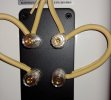antcollinet
Grand Contributor
Other than the possible low volume issue you have mentioned, it will make absolutely no difference.Which superposition will better in this matter?!
I think the low volume issue you mention will be channel imbalance - possibly non linearity if at very low volumes. In this case, then yes you will be better off using the DAC volume.
If you are going to do that, I'd suggest turning the DAC up to full, setting the amp volume to the maximum you could ever want to listen to (or alternatively the maximum safe level for your speakers), and then use the DAC to turn it down from there.
Last edited:

